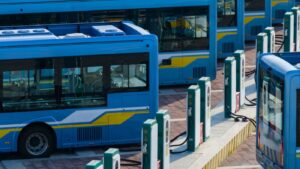Does Ford’s vision of a new transportation value chain suggest Amazon is the future king of transportation?
Ford has had a fast start to 2018, laying out its vision of the future of transportation at the Consumer Electronics Show (CES) and buying two pieces of its future business model shortly thereafter. The transportation-as-a-service (TaaS) business model Ford envisions isn’t anything new, as plenty of players both large and small have been espousing such a vision for some time. The somewhat surprising aspect is that the way Ford is talking about it indicates that defensibility in the TaaS future does not lie in the vehicle manufacturing portion of the business. I agree that TaaS is coming, but there’s a difference between making a bet about the future and winning when that future comes around. If Ford is right about what the moat is and where the defensible margin lies in the future of transportation, doesn’t their logic point to Amazon as the most likely winner?
The future of transportation, according to Ford
In an hour-long talk at CES in January, Ford CEO Jim Hackett laid out his vision of Ford’s role in the future of transportation. This vision is based on transportation “systems” consisting of networked self-driving vehicles – essentially TaaS as any number of others have envisioned it. While many OEMs are furiously developing autonomous driving technology, one uncertainty has been how OEMs will position themselves in this TaaS future. They could continue selling cars with autonomy as a feature of the vehicle, but there’s no requirement that they leverage autonomy as a service and become network operators. Tesla has been going the feature route with its vehicles, largely staying within the traditional business model of a vehicle manufacturer while developing autonomous driving technology. GM is pushing into the service realm with its Bolts, with the plan to roll out an autonomous ride-hailing service in urban areas.

Ford’s perspective aligns with GM’s view about the need to expand beyond vehicle manufacturing, but goes beyond GM and ride-hailing. In an interview with Automotive News published in December, Jim Farley, Ford’s president of global markets, said Ford vehicles “will be used for a host of commercial purposes, such as package delivery,” as Ford has “to have a more diverse revenue model than ride-hailing.” Its actions in early 2018 have demonstrated that these aren’t empty words, as Ford has begun partnering with and acquiring various capabilities to fill out its future business model. Ford announced a partnership with Domino’s Pizza to explore pizza delivery with self-driving vehicles in August 2017, and built on that by launching another partnership with Postmates on January 9 at CES. Simultaneously, Ford announced a partnership with Autonomic, a startup building an open cloud-based platform, to jointly build the “Transportation Mobility Cloud.” Ford then promptly announced it was acquiring Autonomic 16 days later. On the same day it acquired Autonomic, Ford also announced it was acquiring TransLoc, another existing partner that works primarily with public transportation systems in supporting real-time transportation tracking and analytics. Both Autonomic and Transloc are important base layer components of Ford’s Transportation Mobility Cloud future.
What’s the next move?
In the same interview with Automotive News, Farley gave another quote that provides a glimpse into how Ford may be thinking about this business model, saying “anytime you’re not carrying goods and people, you’re losing money.” It should be noted that this was in the context of a hybrid vs battery electric vehicle question (I’ll address that specific topic in a future blog post), but the underlying principle of minimizing the time when a vehicle is not carrying goods or people applies beyond the hybrid vs battery electric issue. This is essentially the economic model for car rental companies or other asset leasing businesses, but on a more granular timescale of minutes and hours vs days. If the moat is in maximizing time the vehicle is in use, Ford should be focused on expanding and locking in its channels that create demand for transportation. This could be in transportation of people, leveraging Transloc’s capabilities and potentially in partnership with Transloc’s municipal customers. Or, this could be in transport of different kinds of goods (last mile delivery).

A major challenge for Ford in last mile delivery is that Amazon has been extending its transportation offerings for some time and is already in the spaces where Ford is conducting pilots. In addition to the goods and hot meal delivery spaces, Amazon is also in groceries, and just launched a free two-hour Whole Foods delivery pilot. Grocery chains have been anticipating this since the Amazon-Whole Foods merger, with a string of grocery chains having announced partnerships with delivery services since then, plus Target acquiring Shipt. Had Instacart not raised a fresh $200M round of financing, I would have suggested it as a potential near- to mid-term acquisition target for Ford due to its rapidly growing number of grocer partnerships that now include Costco, Albertsons, Publix, Kroger, Ahold, and H-E-B. A partnership with Instacart would still be a highly attractive channel for Ford to enter the grocery delivery market.
A grocery delivery partnership or pilot would get Ford into the same types of delivery services as Amazon, but at that point both would still be missing offerings for the transportation of people. While Ford has a path to such offerings with Transloc, when autonomous vehicles hit the streets, the barriers to entry will be extremely low for Amazon:
- Driver acquisition costs? Gone – drivers will come with the vehicle.
- All that money that Uber, Lyft, and similar ride-hailing companies have had to spend on rider acquisition? Amazon already has 90 million Prime customers in the US alone.
Essentially, vehicle autonomy turns TaaS into a one-sided (customer-facing) product offering, as opposed to the two-sided (driver and customer) platform business that it is today without autonomy.

A key variable for Amazon’s expansion into transportation of people could be the growth of its brick-and-mortar retail locations, where transportation to the location becomes a piece of the customer experience… and customer experience is a key piece of Jeff Bezos’ flywheel of growth. Could Amazon start by offering free rides to and from its retail locations in select cities? Just as Amazon is experimenting with removing the friction in the grocery checkout process with Amazon Go, it could remove the friction of driving and especially parking from the physical shopping experience.
Although the timing of where and when Amazon may expand its transportation offerings is unclear, it does appear to be the better positioned player if the transportation value chain evolves in the way Ford (and many others) envision. Given that, one has to wonder whether the transportation sector’s frantic rush to autonomy is a headlong rush into territory where Amazon awaits with its moat already in place.
Disclosure: I am long AMZN.


